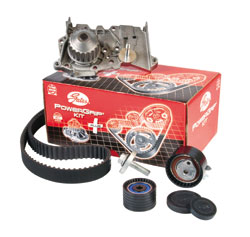
 When cooling system problems arise, determining the difference between a symptom and a cause can prove a difficult exercise.
When cooling system problems arise, determining the difference between a symptom and a cause can prove a difficult exercise.
To combat this, a new publication from Gates – Diagnostic Made Easy – could help, especially in the event that the temperature gauge on the vehicle is continuously in the red.
The guide makes things easy by taking you on a logical progression through the steps that make up a successful investigation procedure, such as:
Check the coolant level, adding more until ‘Max’ is achieved. Ensure the radiator fan system is operating correctly by checking the temperature sensor and the wiring. Consider whether the coolant could be either old or contaminated. If so, this will require a system flush, followed by a refill with new coolant.
Coolant may look clean, but looks can be deceiving. Some contaminants – such as aluminium corrosion particles or mineral content in the water – may be less than obvious so coolant should be changed every 31,000 miles to be on the safe side.
If the cooling system on a high-mileage vehicle has never been flushed, for example, contamination is highly probable. A drain, flush and refill should be carried out as part of a preventive maintenance programme – it’s not designed to rectify problems.
Colour blind
Mixing different types of coolant can cause further issues – as well as ‘voiding’ a manufacturer’s warranty. Some coolants may be the same colour but the ingredients may be different. If in doubt, the manufacturer’s recommended specification is always the correct decision. If all seems fine, proceed to the next phase.
Intensify the search
It’s time to escalate the investigation process. As well as reducing circulation, air bubbles can accelerate the corrosion process so you should then look to bleed the system. This can be achieved via the bleeding valve on the upper radiator hose (if there is one) but, on some models, air must be vented from the expansion tank, which may have to be removed.
If the problem persists, check to see if there is an electrically driven water pump. The average water pump handles 1.7 million litres of coolant in 100,000 km (or every four years). Failure rates can be quicker, however.
Water pump wear
The Gates Cooling Systems Troubleshooting Guide identifies the major signs of wear and water pump failure patterns. These include: worn/damaged bearings; noise; weep hole leaks; leaks from the mounting surface; corrosion; scale and deposit build-up; cavitations (caused by thermodynamic pressure) and a broken shaft.
If none of these are identified, establish whether the tension of the belt is correct. If not, the pump may have been running inefficiently for some time, so take no chances by fitting a new drive belt kit and a water pump at the same time.
An added value benefit is that the correct water pump model is guaranteed, while all parts are from the same supplier. That means the warranty extends to all of them. In the unlikely event of a future issue, just one supplier means only one inspection.
What’s more, the standard times for fitting the belt kit and installing the water pump at the same time are the same as just installing the kit. So the customer drives away happy with the added value and the extra peace of mind.

The Kit Plus Water Pump range from Gates contains a drive belt kit and water pump









